Hongshen Xu
DiSRouter: Distributed Self-Routing for LLM Selections
Oct 22, 2025Abstract:The proliferation of Large Language Models (LLMs) has created a diverse ecosystem of models with highly varying performance and costs, necessitating effective query routing to balance performance and expense. Current routing systems often rely on a centralized external router trained on a fixed set of LLMs, making them inflexible and prone to poor performance since the small router can not fully understand the knowledge boundaries of different LLMs. We introduce DiSRouter (Distributed Self-Router), a novel paradigm that shifts from centralized control to distributed routing. In DiSRouter, a query traverses a network of LLM agents, each independently deciding whether to answer or route to other agents based on its own self-awareness, its ability to judge its competence. This distributed design offers superior flexibility, scalability, and generalizability. To enable this, we propose a two-stage Self-Awareness Training pipeline that enhances each LLM's self-awareness. Extensive experiments demonstrate that DiSRouter significantly outperforms existing routing methods in utility across various scenarios, effectively distinguishes between easy and hard queries, and shows strong generalization to out-of-domain tasks. Our work validates that leveraging an LLM's intrinsic self-awareness is more effective than external assessment, paving the way for more modular and efficient multi-agent systems.
MiMo: Unlocking the Reasoning Potential of Language Model -- From Pretraining to Posttraining
May 12, 2025Abstract:We present MiMo-7B, a large language model born for reasoning tasks, with optimization across both pre-training and post-training stages. During pre-training, we enhance the data preprocessing pipeline and employ a three-stage data mixing strategy to strengthen the base model's reasoning potential. MiMo-7B-Base is pre-trained on 25 trillion tokens, with additional Multi-Token Prediction objective for enhanced performance and accelerated inference speed. During post-training, we curate a dataset of 130K verifiable mathematics and programming problems for reinforcement learning, integrating a test-difficulty-driven code-reward scheme to alleviate sparse-reward issues and employing strategic data resampling to stabilize training. Extensive evaluations show that MiMo-7B-Base possesses exceptional reasoning potential, outperforming even much larger 32B models. The final RL-tuned model, MiMo-7B-RL, achieves superior performance on mathematics, code and general reasoning tasks, surpassing the performance of OpenAI o1-mini. The model checkpoints are available at https://github.com/xiaomimimo/MiMo.
Alignment for Efficient Tool Calling of Large Language Models
Mar 09, 2025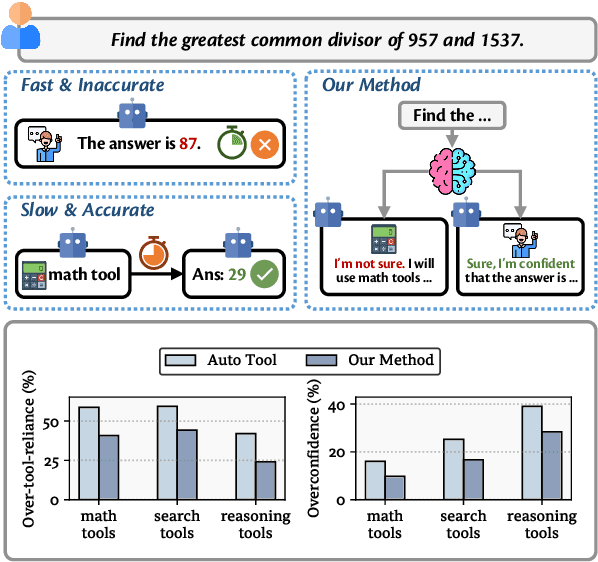
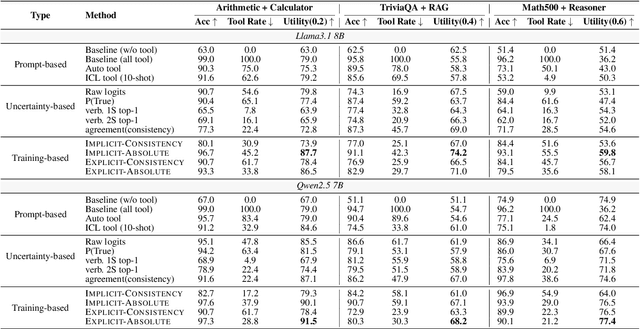
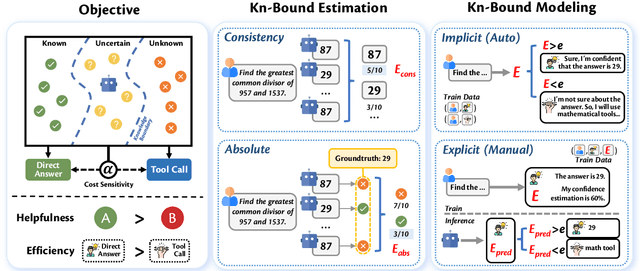
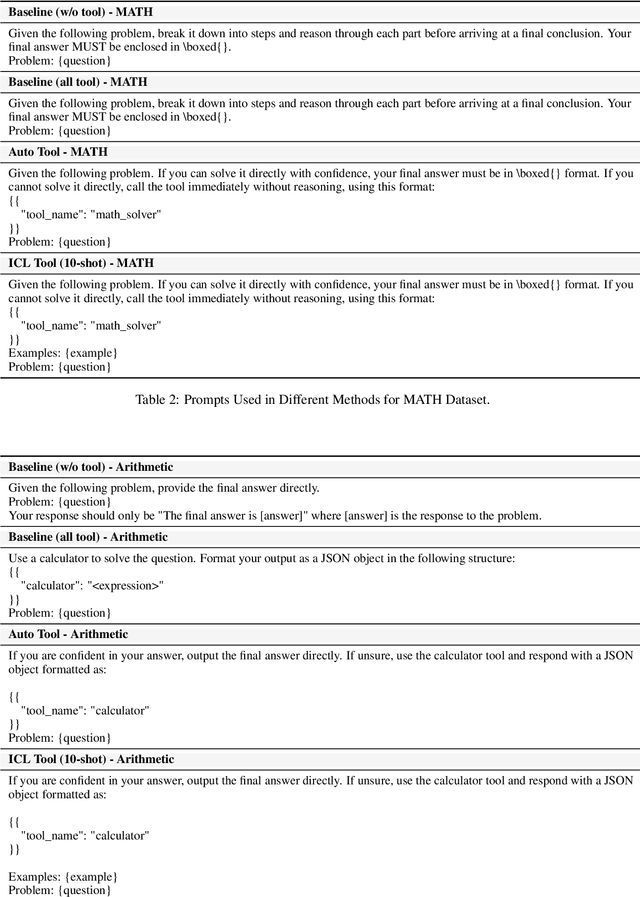
Abstract:Recent advancements in tool learning have enabled large language models (LLMs) to integrate external tools, enhancing their task performance by expanding their knowledge boundaries. However, relying on tools often introduces tradeoffs between performance, speed, and cost, with LLMs sometimes exhibiting overreliance and overconfidence in tool usage. This paper addresses the challenge of aligning LLMs with their knowledge boundaries to make more intelligent decisions about tool invocation. We propose a multi objective alignment framework that combines probabilistic knowledge boundary estimation with dynamic decision making, allowing LLMs to better assess when to invoke tools based on their confidence. Our framework includes two methods for knowledge boundary estimation, consistency based and absolute estimation, and two training strategies for integrating these estimates into the model decision making process. Experimental results on various tool invocation scenarios demonstrate the effectiveness of our framework, showing significant improvements in tool efficiency by reducing unnecessary tool usage.
Delusions of Large Language Models
Mar 09, 2025Abstract:Large Language Models often generate factually incorrect but plausible outputs, known as hallucinations. We identify a more insidious phenomenon, LLM delusion, defined as high belief hallucinations, incorrect outputs with abnormally high confidence, making them harder to detect and mitigate. Unlike ordinary hallucinations, delusions persist with low uncertainty, posing significant challenges to model reliability. Through empirical analysis across different model families and sizes on several Question Answering tasks, we show that delusions are prevalent and distinct from hallucinations. LLMs exhibit lower honesty with delusions, which are harder to override via finetuning or self reflection. We link delusion formation with training dynamics and dataset noise and explore mitigation strategies such as retrieval augmented generation and multi agent debating to mitigate delusions. By systematically investigating the nature, prevalence, and mitigation of LLM delusions, our study provides insights into the underlying causes of this phenomenon and outlines future directions for improving model reliability.
Enhancing LLM Reliability via Explicit Knowledge Boundary Modeling
Mar 04, 2025Abstract:Large language models (LLMs) frequently hallucinate due to misaligned self-awareness, generating erroneous outputs when addressing queries beyond their knowledge boundaries. While existing approaches mitigate hallucinations via uncertainty estimation or query rejection, they suffer from computational inefficiency or sacrificed helpfulness. To address these issues, we propose the Explicit Knowledge Boundary Modeling (EKBM) framework, integrating fast and slow reasoning systems to harmonize reliability and usability. The framework first employs a fast-thinking model to generate confidence-labeled responses, enabling immediate use of high-confidence outputs. For uncertain predictions, a slow refinement model conducts targeted reasoning to improve accuracy. To align model behavior with our proposed object, we propose a hybrid training pipeline, enhancing self-awareness without degrading task performance. Evaluations on dialogue state tracking tasks demonstrate that EKBM achieves superior model reliability over uncertainty-based baselines. Further analysis reveals that refinement substantially boosts accuracy while maintaining low computational overhead. Our work establishes a scalable paradigm for advancing LLM reliability and balancing accuracy and practical utility in error-sensitive applications.
Reducing Tool Hallucination via Reliability Alignment
Dec 05, 2024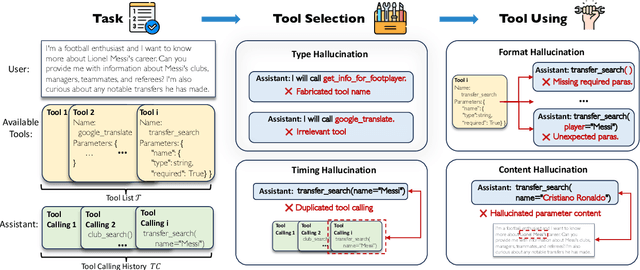
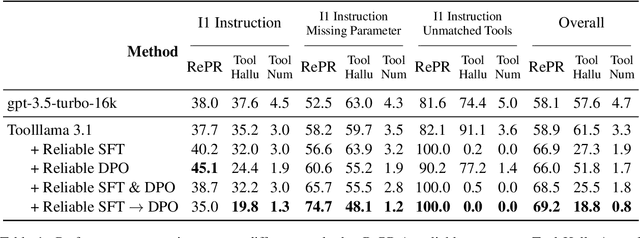
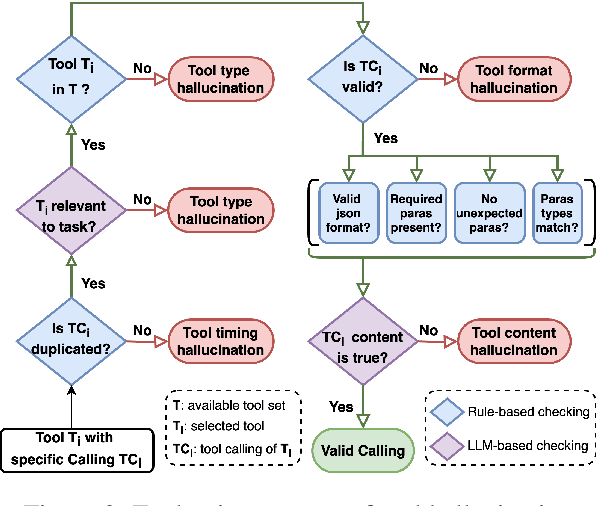
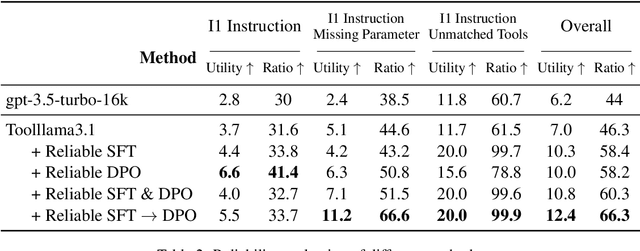
Abstract:Large Language Models (LLMs) have extended their capabilities beyond language generation to interact with external systems through tool calling, offering powerful potential for real-world applications. However, the phenomenon of tool hallucinations, which occur when models improperly select or misuse tools, presents critical challenges that can lead to flawed task execution and increased operational costs. This paper investigates the concept of reliable tool calling and highlights the necessity of addressing tool hallucinations. We systematically categorize tool hallucinations into two main types: tool selection hallucination and tool usage hallucination. To mitigate these issues, we propose a reliability-focused alignment framework that enhances the model's ability to accurately assess tool relevance and usage. By proposing a suite of evaluation metrics and evaluating on StableToolBench, we further demonstrate the effectiveness of our framework in mitigating tool hallucination and improving the overall system reliability of LLM tool calling.
Compressing KV Cache for Long-Context LLM Inference with Inter-Layer Attention Similarity
Dec 03, 2024Abstract:The increasing context window size in Large Language Models (LLMs), such as the GPT and LLaMA series, has improved their ability to tackle complex, long-text tasks, but at the cost of inference efficiency, particularly regarding memory and computational complexity. Existing methods, including selective token retention and window-based attention, improve efficiency but risk discarding important tokens needed for future text generation. In this paper, we propose an approach that enhances LLM efficiency without token loss by reducing the memory and computational load of less important tokens, rather than discarding them.We address two challenges: 1) investigating the distribution of important tokens in the context, discovering recent tokens are more important than distant tokens in context, and 2) optimizing resources for distant tokens by sharing attention scores across layers. The experiments show that our method saves $35\%$ KV cache without compromising the performance.
Spider2-V: How Far Are Multimodal Agents From Automating Data Science and Engineering Workflows?
Jul 15, 2024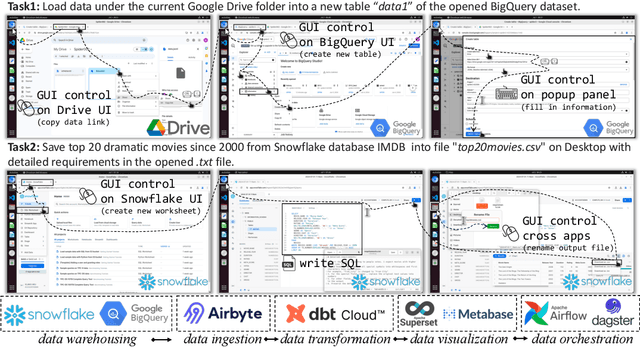
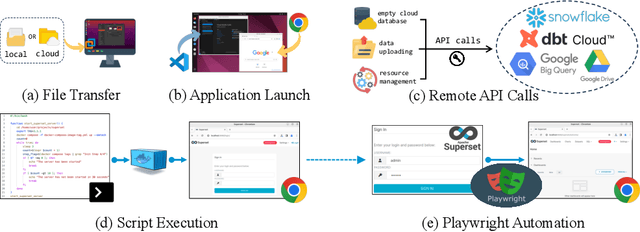
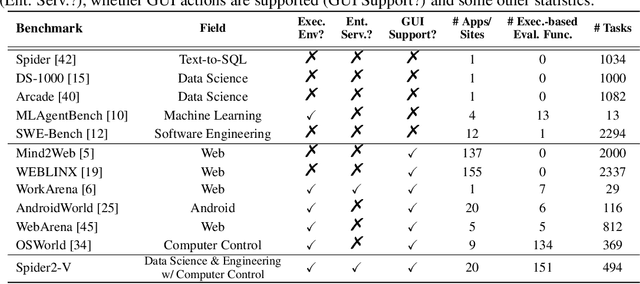
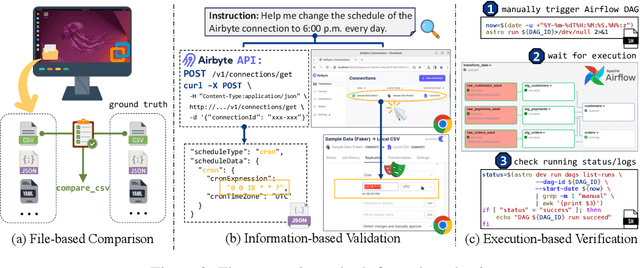
Abstract:Data science and engineering workflows often span multiple stages, from warehousing to orchestration, using tools like BigQuery, dbt, and Airbyte. As vision language models (VLMs) advance in multimodal understanding and code generation, VLM-based agents could potentially automate these workflows by generating SQL queries, Python code, and GUI operations. This automation can improve the productivity of experts while democratizing access to large-scale data analysis. In this paper, we introduce Spider2-V, the first multimodal agent benchmark focusing on professional data science and engineering workflows, featuring 494 real-world tasks in authentic computer environments and incorporating 20 enterprise-level professional applications. These tasks, derived from real-world use cases, evaluate the ability of a multimodal agent to perform data-related tasks by writing code and managing the GUI in enterprise data software systems. To balance realistic simulation with evaluation simplicity, we devote significant effort to developing automatic configurations for task setup and carefully crafting evaluation metrics for each task. Furthermore, we supplement multimodal agents with comprehensive documents of these enterprise data software systems. Our empirical evaluation reveals that existing state-of-the-art LLM/VLM-based agents do not reliably automate full data workflows (14.0% success). Even with step-by-step guidance, these agents still underperform in tasks that require fine-grained, knowledge-intensive GUI actions (16.2%) and involve remote cloud-hosted workspaces (10.6%). We hope that Spider2-V paves the way for autonomous multimodal agents to transform the automation of data science and engineering workflow. Our code and data are available at https://spider2-v.github.io.
Sparsity-Accelerated Training for Large Language Models
Jun 03, 2024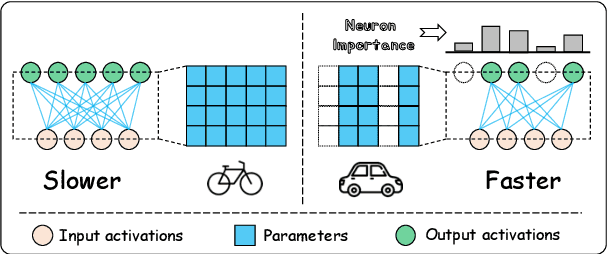
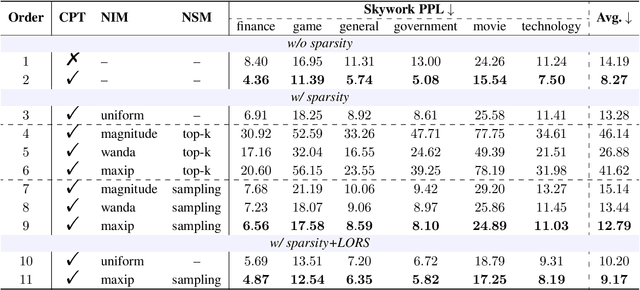
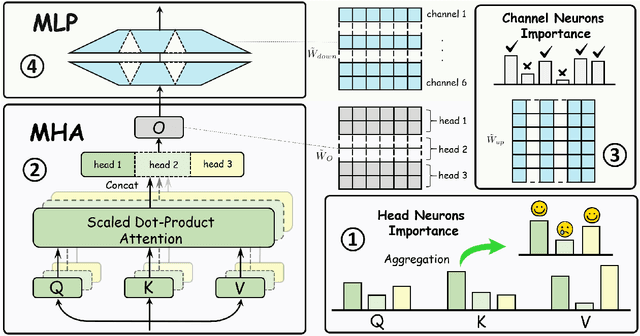

Abstract:Large language models (LLMs) have demonstrated proficiency across various natural language processing (NLP) tasks but often require additional training, such as continual pre-training and supervised fine-tuning. However, the costs associated with this, primarily due to their large parameter count, remain high. This paper proposes leveraging \emph{sparsity} in pre-trained LLMs to expedite this training process. By observing sparsity in activated neurons during forward iterations, we identify the potential for computational speed-ups by excluding inactive neurons. We address associated challenges by extending existing neuron importance evaluation metrics and introducing a ladder omission rate scheduler. Our experiments on Llama-2 demonstrate that Sparsity-Accelerated Training (SAT) achieves comparable or superior performance to standard training while significantly accelerating the process. Specifically, SAT achieves a $45\%$ throughput improvement in continual pre-training and saves $38\%$ training time in supervised fine-tuning in practice. It offers a simple, hardware-agnostic, and easily deployable framework for additional LLM training. Our code is available at https://github.com/OpenDFM/SAT.
CoE-SQL: In-Context Learning for Multi-Turn Text-to-SQL with Chain-of-Editions
May 04, 2024Abstract:Recently, Large Language Models (LLMs) have been demonstrated to possess impressive capabilities in a variety of domains and tasks. We investigate the issue of prompt design in the multi-turn text-to-SQL task and attempt to enhance the LLMs' reasoning capacity when generating SQL queries. In the conversational context, the current SQL query can be modified from the preceding SQL query with only a few operations due to the context dependency. We introduce our method called CoE-SQL which can prompt LLMs to generate the SQL query based on the previously generated SQL query with an edition chain. We also conduct extensive ablation studies to determine the optimal configuration of our approach. Our approach outperforms different in-context learning baselines stably and achieves state-of-the-art performances on two benchmarks SParC and CoSQL using LLMs, which is also competitive to the SOTA fine-tuned models.
 Add to Chrome
Add to Chrome Add to Firefox
Add to Firefox Add to Edge
Add to Edge